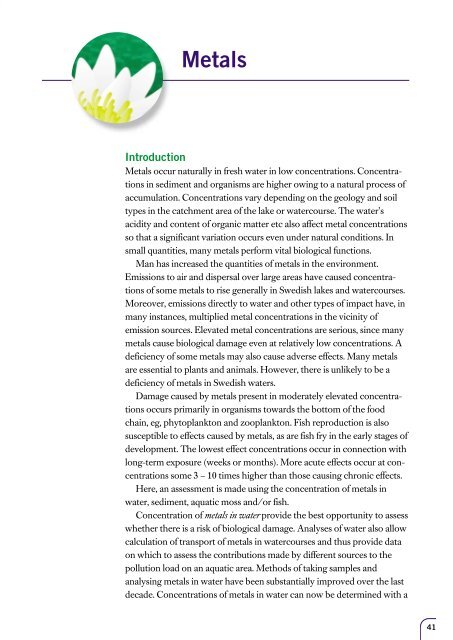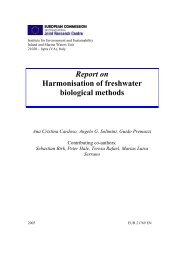Lakes and Watercourses
Lakes and Watercourses
Lakes and Watercourses
Create successful ePaper yourself
Turn your PDF publications into a flip-book with our unique Google optimized e-Paper software.
Metals<br />
Introduction<br />
Metals occur naturally in fresh water in low concentrations. Concentrations<br />
in sediment <strong>and</strong> organisms are higher owing to a natural process of<br />
accumulation. Concentrations vary depending on the geology <strong>and</strong> soil<br />
types in the catchment area of the lake or watercourse. The water’s<br />
acidity <strong>and</strong> content of organic matter etc also affect metal concentrations<br />
so that a significant variation occurs even under natural conditions. In<br />
small quantities, many metals perform vital biological functions.<br />
Man has increased the quantities of metals in the environment.<br />
Emissions to air <strong>and</strong> dispersal over large areas have caused concentrations<br />
of some metals to rise generally in Swedish lakes <strong>and</strong> watercourses.<br />
Moreover, emissions directly to water <strong>and</strong> other types of impact have, in<br />
many instances, multiplied metal concentrations in the vicinity of<br />
emission sources. Elevated metal concentrations are serious, since many<br />
metals cause biological damage even at relatively low concentrations. A<br />
deficiency of some metals may also cause adverse effects. Many metals<br />
are essential to plants <strong>and</strong> animals. However, there is unlikely to be a<br />
deficiency of metals in Swedish waters.<br />
Damage caused by metals present in moderately elevated concentrations<br />
occurs primarily in organisms towards the bottom of the food<br />
chain, eg, phytoplankton <strong>and</strong> zooplankton. Fish reproduction is also<br />
susceptible to effects caused by metals, as are fish fry in the early stages of<br />
development. The lowest effect concentrations occur in connection with<br />
long-term exposure (weeks or months). More acute effects occur at concentrations<br />
some 3 – 10 times higher than those causing chronic effects.<br />
Here, an assessment is made using the concentration of metals in<br />
water, sediment, aquatic moss <strong>and</strong>/or fish.<br />
Concentration of metals in water provide the best opportunity to assess<br />
whether there is a risk of biological damage. Analyses of water also allow<br />
calculation of transport of metals in watercourses <strong>and</strong> thus provide data<br />
on which to assess the contributions made by different sources to the<br />
pollution load on an aquatic area. Methods of taking samples <strong>and</strong><br />
analysing metals in water have been substantially improved over the last<br />
decade. Concentrations of metals in water can now be determined with a<br />
41















![Accommodation booking form [PDF]](https://img.yumpu.com/39471785/1/184x260/accommodation-booking-form-pdf.jpg?quality=85)

